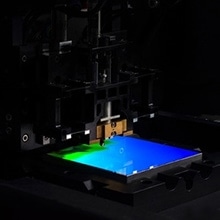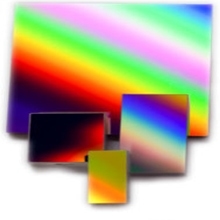As a key component of many technologies, diffraction gratings disperse polychromatic light into different wavelengths, providing precise division, resolution, and intensity for a variety of applications. Depending on your needs, diffraction gratings vary in size, shape, composition material, and other factors.
There are many types of diffraction gratings, each of which lend themselves to crucial applications in industries such as aerospace, defense, life sciences, and semiconductor. Here we’ll review the types of diffraction gratings, their characteristics and composition, and some of their common applications.
Overview of Diffraction Gratings
Diffraction gratings are glass substrates that feature a layer of deposited aluminum that has been pressure-ruled using a diamond edge to create several fine equidistant grooves. These optical devices are used to disperse light into a series of spectra, separating wavelengths based on the angle in which they emerge.
The main types of diffraction gratings include:
- Ruled gratings. Ruled gratings are fabricated by cutting or scratching parallel lines or grooves into a polished substrate, which is used to divide light and provide a clear separation of wavelengths. This etching is done on a clear substrate in a repetitive, parallel structure.
- Reflection gratings. Reflective gratings are typically created by depositing a metal coating onto the etched optical substrate. When using a reflection grating, the light reflects off the ruled surface at various angles which correspond to different wavelengths and orders.
- Transmission gratings. Unlike reflection gratings which use a reflective coating, light passes directly through the material in which the transmission grating was etched, allowing for relatively low polarization sensitivity.
- Echelle diffraction gratings. Echelle gratings are a special type of blazed grating with a lower groove density. The groove tiers are deeper than traditional gratings but still intersect at right angles, which allows diffracted light to be dispersed in a series of overlapping orders.
- Dual blaze diffraction gratings. Dual-blaze gratings are characterized by two sets of grooves on the substrate, which broaden and provide greater efficiency over the wavelength response band.
- Holographic gratings. This type of grating is optically created by recording an interference pattern onto a photoresist coated substrate. Holographic gratings offer high efficiency and great wavefront flatness for a single polarization plane.
Materials Used in Diffraction Gratings
Diffraction gratings are manufactured from a variety of materials, including but not limited to:
- Fused silica. Fused silica is a noncrystalline glass material that features extreme transparency, hardness, and temperature resistance. Fused silica diffraction gratings are ideal for applications exposed to extreme temperatures and other harsh conditions.
- Borofloat®. This glass material features excellent chemical resistance and high thermal stability, making it ideal for use in extreme environments.
- Zerodur®. This low-expansion glass material offers excellent resistance to temperature changes and environmental factors.
- Ceramics. Ceramic materials such as silicon carbide and aluminum nitride offer a low coefficient of thermal expansion and are lightweight.
Coating Options
Several coating options, often referred to as “high-efficiency reflective coatings” may also be applied to the grating. These coatings control the reflected wavelengths, helping prevent reflected waves from interfering with diffraction readings. Commonly utilized reflective materials for these coatings include:
- Enhanced Al/MgF2
- Gold
- Platinum
- Aluminum
- And others
Common Diffraction Grating Applications
When selecting a material for diffraction gratings, it is crucial to consider the requirements of your application. Common applications for diffraction gratings include:
- UV-VIS-IR spectroscopy
- Analytical instrumentation
- Atomic analysis
- Laser tuning
- Spectrographs and monochromators
- Molecular analysis
- Telecommunication applications such as WDM, CWDM, and DWDM
- Metrology instruments
Diffraction Grating Shapes, Styles, and Specifications
Diffraction gratings are fabricated in a variety of geometries depending on application requirements. Plane (flat) gratings and concave gratings are most common, although some applications require convex or toroidal gratings. Plane gratings are highly efficient at directing lower orders of light at specific wavelengths, whereas concave gratings produce well-defined spectral lines without requiring mirrors or lenses, which makes them useful for applications dealing in the infrared and ultraviolet frequency ranges. Gratings may also be square, round, rectangular, or shaped to suit specific requirements.
Diffraction Gratings from OPCO Laboratory, Inc.
At OPCO Laboratory, Inc., we specialize in fabricating precision-grade diffraction gratings for many applications. To suit various applications, OPCO Laboratory, Inc. offers the following specifications:
- Type: plane (flat)
- Dimensions: 5mm to 100 mm long
- Thickness: ≥ 1mm
- Surface Accuracy: λ/4 typical
- Shape: Square, round, rectangular, or customer-specified
- Grooves/mm: 30 to 3600
- Wavelength Range: UV to mid-IR
We are an ITAR-registered facility and have over 40 years of optical design and manufacturing experience. Our high-quality stock diffraction gratings, along with our custom-designed and manufactured gratings, meet and exceed industry standards. We can also fabricate masters for custom ruled diffraction gratings that meet even the most stringent requirements.
Our experience and state-of-the-art grating equipment provide us with the capability to create stock or custom gratings at high volume rapidly and with high precision. For more information about our diffraction gratings, contact our optical experts today.

